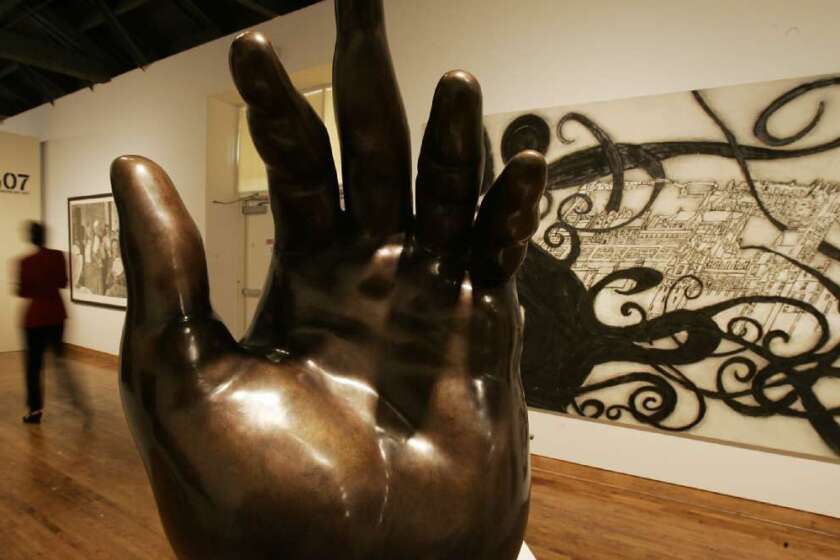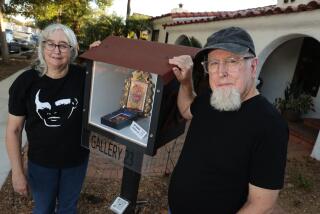Commentary: How can a museum think it owns too much work by important artists? Ask this one
- Share via
When an art museum collects an artist’s work in depth, that’s a virtue, not a vice. No artist is known by a single work of art, major or minor; no cultural milieu deeply illuminated by one of this, one of that.
But you wouldn’t know it from the Museum of Latin American Art in Long Beach, which just tried to auction almost five dozen works from its permanent collection through an online e-commerce site. (Think Etsy with pretensions.) The cockamamie reasoning: It had too many examples by a number of the 20th century’s most significant artists.
Too many works by the Chilean Roberto Matta (1911-2002), seminal Surrealist, huge influence on New York School abstraction and one of the two artists in the auction most celebrated internationally. Twenty prints and one drawing went up for sale.
Too many works by Wifredo Lam (1902-82), the great Afro-Chinese Cuban artist whose spiky figures — hybrids of human, animal and vegetable — speak of the complex island culture’s multicultural spiritual history. Two etchings, sold.
Too many works by José Luis Cuevas (1934-2017), the Mexican painter who struggled with mixed success against the near-suffocating stranglehold that grew around the nation’s extraordinary mural tradition. One painting — a gift of the artist to the museum — and 10 graphics were put on the block.
Too many works by Rafael Coronel (1931-2019), a talented if relatively conservative painter who injected an atmospheric, often melancholic realism into figurative Mexican art dominated by the heroic legacy of his father-in-law, Diego Rivera. Four oil paintings went to market, including a 1965 canvas carrying the auction’s highest estimate.
Too many works by Emilio Sanchez (1921-99), an expatriate to the United States from a wealthy, aristocratic Cuban family, who merged architectural subjects with geometric abstraction. Seven graphics, all sold.
Too many works by Ray Smith (born 1959), a gifted Mexican American painter whose monumental Neo-Surrealist triptych, now peddled, was one of four of his works in the collection. Almost never should a museum auction work by a living artist, for fear of damaging a reputation.
The museum, invoking a now-standard excuse to go shopping, defended these ill-advised sales as fundraising to diversify the holdings of its modest permanent collection, which numbers about 1,300 works. The majority were acquired by MOLAA’s late founder, physician and wealthy healthcare executive Robert Gumbiner, an amateur enthusiast more devoted to buying what he liked than to creating a serious museum collection of modern and contemporary art.
MOLAA’s collection is, to be charitable, spotty. But the bizarre claim that certain first-rate artists are “overrepresented” in the collection, which chief curator Gabriela Urtiaga offered to The Times as a rationale for trying to unload 59 works, mostly graphics, does not inspire confidence in upgrading it.
Urtiaga, who last year joined the MOLAA staff from the Centro Cultural Kirchner in Buenos Aires, has an impressive record as an organizer of temporary exhibitions but no evident experience with the very different, very complex question of building a museum collection. It may be true that 80% of MOLAA’s collection is art made by men; but it’s foolish to attempt to deflate that percentage by selling the work of important male artists collected in some depth.
Museum collections are strengthened by the addition of important art, not by its subtraction.
MoLAA in Long Beach makes the controversial move to sell pieces from its permanent collection, citing diversity as the goal.
Fortunately, the online sale was not a success. In fact, it was pretty much a fiasco.
Dropping museum art onto a low-rent e-commerce site was bad enough. (Effectively, MOLAA was selling direct from its storeroom.) Perhaps the insulting context helps explain why, of six works with high estimates in excess of $25,000, three did not sell — including the Coronel. The three that did brought less than their low estimates.
The 12-foot-by-8-foot Smith brought just $4,250. Apparently, given an already surprising low estimate of $10,000, there was no reserve price below which it would not be sold, so — poof! — off it went. With luck, such dismal sale results will caution against a repeat before more damage is done.
Like the Baltimore Museum of Art, which recently withdrew from a planned sell-off of major, big-ticket art from its collection, MOLAA insists the sale was A) absolutely not driven by pandemic-related financial stress and B) fully compliant with a recent, temporary loosening of industry-wide deaccession restrictions so that museums struggling with pandemic-related financial stress can survive.
You see the problem: Can’t be both. Explanations A and B contradict each other. After the fact, MOLAA is fishing for a justification.
Meanwhile, Baltimore and MOLAA, along with some other prominent museums, are carelessly cranking up a bigger potential liability. They’re behaving like for-profit art dealers, rather than nonprofit art museums. Treating the permanent collection as a capital asset to be easily monetized threatens the institution’s charitable status.
If and when that harebrained practice hits critical mass, stand back. The IRS is not likely to be amused.
More to Read
The biggest entertainment stories
Get our big stories about Hollywood, film, television, music, arts, culture and more right in your inbox as soon as they publish.
You may occasionally receive promotional content from the Los Angeles Times.











